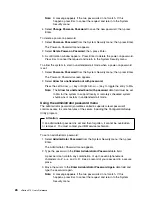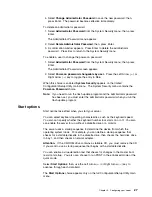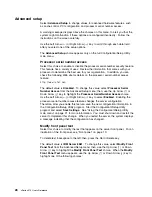
Your server comes with the following hardware configuration programs:
Configuration/Setup Utility
With the built-in Configuration/Setup Utility program, you can configure I/O
functions, such as serial and parallel port assignments; change interrupt
request (IRQ) settings; and change the startup sequence for drives that you
install. You also can use this program to set passwords for starting up the
server and accessing the Configuration/Setup Utility program.
SCSISelect Utility
With the built-in SCSISelect Utility program, you can configure the SCSI
devices that you attach to the SCSI controller. You can use SCSISelect to
change default values, resolve configuration conflicts, and perform a low-level
format on a SCSI hard disk drive.
Before installing a new device or program, read the documentation that comes with
it. Reading the instructions helps you to determine the steps required for
installation and configuration. The following actions are typically, but not always,
required to configure your server.
1. Run the Configuration/Setup Utility program and record the current
configuration settings.
2. Set jumpers or switches on server components.
See “Changing jumper settings” on page 111 and “I/O function card jumpers”
on page 104.
3. Set jumpers or switches on the device.
See the device installation instructions.
4. Install the device in the server.
See Chapter 4, “Installing options” on page 37.
5. Install software programs.
See the installation instructions that come with the software.
6. Resolve configuration conflicts.
See “Resolving configuration conflicts” on page 32.
The Configuration/Setup Utility program
For most configurations, the server will operate using the default system settings.
You need to change the settings only to resolve configuration conflicts or to enable
or change device functions (for example, defining diskette types, and so on).
When you want or need to change the default settings, the Configuration/Setup
Utility program provides a convenient way to display and change the settings.
After you run and exit from the Configuration/Setup Utility program, configuration
information is stored in electrically erasable programmable read-only memory
(EEPROM). While the server is off, the configuration information remains available
for the next system startup.
Always run the Configuration/Setup Utility program if you add, remove, or relocate
any hardware option, or if you receive an error message instructing you to do so.
20
xSeries 370 User's Reference
Summary of Contents for eServer 370 xSeries
Page 1: ...User s Reference xSeries 370...
Page 2: ......
Page 3: ...IBM xSeries 370 User s Reference...
Page 32: ...16 xSeries 370 User s Reference...
Page 188: ...172 xSeries 370 User s Reference...






























